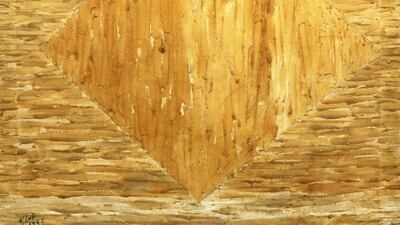Satirical, unstudied and unpolished photographs made by Hassan Sharif and Mohammed Kazem that are on view at the Venetian Arsenal look remarkably current. Yet, they were taken between 20 and 30 years ago.
Amid a vast Venetian spectacle devoted to contemporary art, the UAE pavilion at the 2015 Venice Biennale is looking back – to the country’s roots in modern art.
1980 – Today: Exhibitions in the United Arab Emirates surveys more than 40 years of art. Sculptures made by Emiratis, such as Najat Meky in 1982, bring a magic to ordinary materials. Conceptual work by Sharif and Kazem can be as befuddling as it might have been in the 1980s and 1990s.
The show is the work of Sheikha Hoor Al Qasimi, president and director of the Sharjah Art Foundation. She is the first Emirati to curate the UAE pavilion at the Venice Biennale.
“This is the art that I grew up with,” says Sheikha Hoor. “This is what led me into working in the arts. This was the exposure that led me to want to be an artist, to curate and, ultimately, to work on the biennial.”
An eclectic selection of works by 15 artists covers the brick walls of the Hall of Arms (Sale d’Armi) in a former fort, bordered by the pavilions of Mexico, Argentina and the Vatican. The range of art comes as a revelation. So do the collections by some of the individual artists.
From Sharif, born in 1951, are playful no-budget self-documentations and notebooks bound with string. Yet Sharif’s 1985 framed compositions in zinc and boiled linseed oil on canvas have the serene palette of golden sand and the brushstrokes of oil painting.
A similar range can be seen in the work of Mohammed Yousif, 62, who made radically simple wooden sculptures in the 1980s, such as Divorced Woman, an iconic figure with its arms raised. Yousif also created oddly lifelike figures assembled from recycled pipes and bicycle wheels, balanced on three metal strands that look like legs, which have an energy that makes them seem poised to move.
“We had our concepts, we had our art, we had our culture, we had many things,” says Yousif of those early days. “We are not starting from zero.”
Sheikha Hoor stresses the modest origins of work from those years.
“People have a misconception of the UAE, that it’s a rich country, with money and new museums and this and that, but when you look at a lot of the artwork, it’s really about whatever is found there, about nature,” she says
Sculptures from 1991 by Abdullah Al Saadi in the natural material of bone were small grotesque figures in the tones of the desert.
Some material realities of artists’ lives are revealed in a diary that Al Saadi began keeping in 1984, when he was in high school. Excerpts are reprinted in the exhibition catalogue. Art materials were expensive, the young artist notes on pages where he also draws. He borrowed glue from his brother to attach small stones to his pictures. They improvised when it came to studio space and electricity.
He writes: “The Emirates Fine Arts Society announced the winners of their Seventh Exhibition in Sharjah yesterday, but my name was unfortunately not on the list. I did not go to the event for two reasons: the first was that I didn’t have a single dirham and was embarrassed to ask my friends for money; the second is that I have my Cultural History of Literature exam tomorrow.”
In Tongue (1994), the only work on view by Mohammed Kazem, who represented the UAE at the 2013 biennale, framed sets of now-faded photographs show the artist making contact with a variety of surfaces with his tongue. "It's sort of tongue in cheek," says Sheikha Hoor. "He's using his tongue to discover objects."
"It's from a series called Autobiographies, about my body," says Kazem. "Of course, I'm dealing with objects more than I'm dealing with the body."
Conceptualists back then were rare, he says. “There were five of us. We were together, but we had no manifesto.”
Conservation of those pictures and other works on view was a challenge, as was finding many of them. “It inspired a lot of the artists to look for their older work, because they didn’t know where things were. Other things were missing when they moved,” says Sheikha Hoor. “In one case, an artist sent me images of another artist.”
Takween (Formation, 1984) by Meky is an earth-toned metal ring with sharp spikes that looks like it might have been recently excavated. On Sheikha Hoor's mobile phone was a photograph of the sculpture from years ago in a radiant blue.
In some cases, artists updated their work. Meky's sculptural relief, Palestine (1995), is a luminous green work that looks new because she repainted it.
In an exhibition about memory, the imperfections are part of the story. “One painting that we borrowed from a private collection had a hole in it,” says Sheikha Hoor, adding: “You couldn’t conserve that.”
• The 56th Venice Biennale runs from Saturday, May 9, until November 22. The official opening of the National Pavilion of the UAE is on Thursday, May 7, at 4.30pm. For more information, visit www.nationalpavilionuae.org
artslife@thenational.ae

